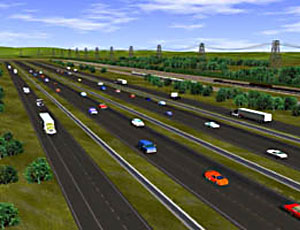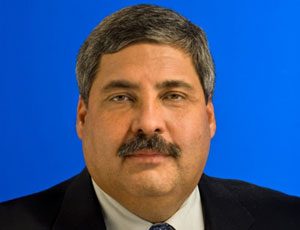The Texas Department of Transportation today announced that it has effectively pulled the plug on its ambitious and widely publicized Trans-Texas Corridor, a comprehensive transportation plan introduced by TxDOT and Texas Gov. Rick Perry (R) in 2002. What was once envisioned as 4,000 miles of existing and new highways, railways and utility rights-of-way now will be attempted in smaller segments.


Major contracting consortiums had lined up to build the first tollways that would be part of the corridor plan as public-private partnerships. How many PPPs will be involved in the scaled back transportation plan remains to be seen.
TxDOT Executive Director Amadeo Saenz, Jr., made the announcement on Jan. 6 at the Fourth Annual Texas Transportation Forum in Austin.
"The Trans-Texas Corridor, as a single project concept, is not the choice of Texans," Saenz says. "So we've decided to put the name to rest."
"The days of the Trans-Texas Corridor are over," Gov. Perry says.
The TTC initiative was one of the governor's largest. Perry was not in attendance at the forum or during the announcement, but spoke with media via teleconference from an undisclosed location in Iraq while attending a Department of Defense delegation trip.
The biannual Texas Legislature convenes next week in Austin, with transportation issues expected to be a major focus.
Perry said the state will continue to work with the Legislature and "use all tools available for building needed infrastructure."
"We don't care what name they attach to infrastructure," Perry says. "The key is we have to go forward and build. The continued focus should be on building and not [being] sidetracked by a particular name."
"TxDOT abolished the Trans-Texas Corridor nomenclature," says Thomas L. Johnson, executive vice president of the AGC of Texas, Highway, Heavy, Utilities and Industrial Branch. "However the different segments of roadway supported by the local areas will continue to be developed." He says that is "an example of TxDOT reaching out to local citizens in the development of needed projects."
Portions of two TTC projects are under development: I-69/TTC, which extends from Texarkana/Shreveport to Mexico--possibly the Rio Grande Valley or Laredo--and TTC-35, which generally parallels I-35 from north of Dallas/Fort Worth to Mexico.
The TTC segments will be referred to by their original name, such as I-69.
Perry said he was not deeply involved in guiding development of the new vision, adding, "I can't oversee every agency every minute of the day." He says that "TxDOT is continuing to make good decisions."
Perry was asked if the project was a public relations failure, or if the sagging economy was more of an issue. His response was "financing is certainly a concern."
When asked if there had been a failure of vision, Perry says he "respectfully disagrees."
"New lanes from Fort Worth to El Paso at the time were not reality, but what Texans want to see in their leaders are broad visions. That's exactly what I've done."
"The concept got misunderstood," he adds. "That certainly plays into the decision TxDOT made and I support their decision."
Saenz, meanwhile, unveiled a revised plan that calls for major changes to the Trans-Texas Corridor, including the project's name, vision and scope. "The T-T-C became the subject of many discussions, sometimes intense ones," Saenz says.
In response, TxDOT officials say the new effort will be driven by more public input including advisory committees comprised of citizens from affected communities as well as town hall meetings.
Saenz told more than 1,000 attendees that the new vision, �Innovative Connectivity in Texas|Vision 2009,' "does not mean that we will abdicate our mission."
"We will still develop transportation projects that move Texas forward."
The Trans-Texas Corridor called for some 4,000 mi of existing and new highways, railways and utility right-of-ways. The network of roads would link major cities statewide from Oklahoma to the border with Mexico. At a cost of nearly $200 billion, it would offer separate passenger and freight roads, commuter and freight rail lines and dedicated zones for water, electric, telecommunications and other utility lines with a timeline for project completion ranging from 2005 to 2025.
The new plan, Saenz says, will continue to pursue projects but will no longer be called the Trans-Texas Corridor. Major corridor projects will be comprised of several small segments no wider than 600 ft, as opposed to the original plan of 1,200-ft-wide corridors.
Private-public partnerships lined up to bid for the first segments of tollways that would become part of the TTC. The first included a PPP that would build a portion of the Central Texas Turnpike System—the State Highway 130 in Central Texas—which is the state's first design-build highway. Lone Star Infrastructure, a joint venture among Fluor Corporation, Irving; Balfour Beatty Construction, Dallas, and T.J. Lambrecht Co., Euless, Texas, recently completed the final segment of the highway in April. Another PPP came in the form of a multi-billion dollar investment from an international consortium, Cintra-Zachry, which includes Zachry Construction Corp. of San Antonio and Madrid-based infrastructure and toll-road developer Cintra.
Saenz says TxDOT will still partner with local governments and entities, "and where appropriate, the private sector, to get needed projects on the ground."
"Citizens across the state have had good ideas about how Texas roads can better serve Texas communities," Saenz says. "I believe this transformed vision for the TTC and other major corridor development goes a long way toward addressing the concerns we've heard over the past several years."


Post a comment to this article
Report Abusive Comment